ITADAKI SAN
2012年02月29日

Takamatsu’s itadaki sans, fishmongers peddling heavily laden tricycles, are unique. They cruise slowly around the town in the mornings, knives sharpened, scales ready and fresh fish cooled on ice for sale at predetermined spots. Some call out; “O sakana ikaga desuka?”

This name derived from the old days when the women would carry a shallow wooden pail with fish on their heads and call “itadaku!” The legend tells us a young princess came from Kyoto, married a Takamatsu local. To support the family she started selling fish from this pail carried around on her head. And that’s how it all started … selling fish outside in this style but now using tricycles. The name “itadaku” which means offering thanks for the food we are about to eat, then came in to being as the call tor her customers. The “san” a suffix similar to ‘madam.’


The numbers of itadaki sans has declined from the peak in the 50s at around 200, then in about ’85 to 100 or so. There were many even in Sakaide and Kannonji but now none. The average age of the current itadaki sans is 70~80

Sadly though, here in Kagawa they are decreasing in numbers every year. “The young girls just don’t have the legs for the job” is how one itadaki san described it to me. “Nope, they just don’t have it these girls, so what are we all gonna do? Mnnn …”

So soon, as with many other things in Japan we’ll be looking for the lost once again. A vibrant part of Japanese culture that allows interactions with well known fish-sellers and customers having a little chat about life, the weather, kids … gives way to impersonal staff at equally impersonal convenience stores and supermarkets. Unlike my conversations with the local barber as a kid. Little snippets of both hair, grapevine news and school-of-life wisdom all free and often useful.

Some itadaki sans know their customers so well they advise the day’s menu and prepare the fish they think the family needs on the day.

The Takamatsu Fish Markets are where the itadaki sans stock up, although some have a direct connection to fishermen and buy directly from the boats. This is an area near Hamano Cho and close to the city. The grounds here are full of fishermen’s nets, black buoys and steel grids for seaweed harvesting, all manner of sundry fishing gear and yet the area is pretty clean considering …

It’s my belief that the itadaki sans sell a fresher, better product and a cheaper one to this fish consuming nation and it makes me sad to know they are on the way out.

Japan and China are two of the world’s biggest consumers of marine products. In December, Marubeni Corp. bought a U.S. marine product factory in Alaska for about $47 million. And with the factory, Marubeni can supply 57.000 tons of marine product mainly Alaskan salmon to Japan and the world. And in November, Mitsubishi purchased a Chilean salmon farming company producing about 20,000 tons of salmon a year. “Owning companies like this is just as valuable to us as owning promising mines or oil fields,” A Marubeni official said (source Daily Yomiuri Business News Feb. 27 2012) Fish farming technologies and overseas resourcing by such giants as Toyota Tsusho Corp. has limits. Sea areas suitable for fish farming are limited and becoming fewer. Coupled with this, the price of feeding the fish with fishmeal has of course also increased.

Indeed, with the world’s fishing stocks in danger of collapse and the dramatic rise of primal sea-life forms, aka jellyfish etc., we all have cause for concern.

So make my order from an itadaki san every time. This seems an ecologically stable and far more sensible way to sell and buy fish.

I felt a little sad writing this article as I’ve realized that along with family barbers we’re losing something important here.
So until next week. Keep all those cards ‘n letters coming in!
Posted by pat at
22:43
The Circle of Life
2012年02月20日
I know, I know, I really did promise to be back here this week with art updates and I will but the opportunity to present a rather remarkable young man’s 88 temple pilgrimage circling around Shikoku was too much to pass up. Ryan Armstrong is a former colleague in the International Affairs Division, great sportsman, excellent dad and all-round gentleman. And … a great bloke to boot. I’ll let him tell the story replete with his magnificent photos for you and include his web address as well:
Through Henro Eyes by Ryan Armstrong
“The world is simple and pure through pilgrim (henro) eyes -- 50,000 steps; a walking stick; a daily marathon of solitary contemplation.
My walking stick (Otsue) braced me along rocky paths and stabilized slippery ground. It helped me up mountains and supported me down. The sutra on my Otsue provided mental exercise during long days and the feel of smooth wood offered familiarity during an unpredictable journey. Its every clack, 50,000 times, beat out a rhythm that moved me through another day afoot. The walking stick became my companion and partner on the Shikoku 88-Temple Circuit.

The Tools
Without time or date
Hat, stick and self
The Henro is a simple feat
I first ventured to Shikoku after hearing my college sempai say, “It’s too difficult, don’t do it.” His words, cautionary though they were, became my motivation for walking the 1200km route. Later, my objectives evolved as I sought to learn about myself and experience the traditional side of Japan.

The Marble Reflection
Along the pilgrim’s path
Did you meet the Daishi?
Yes, everyday.
I walked the pilgrimage twice, once forwards and once backwards. Both times ‘dogyo ninin’ and Shikoku’s ‘osettai no kokoro’ helped me complete my journeys.

The Mossy Wall
On the Henro
Moss and walls became my canvas.
The sun became my paint.
Always at my side
But never within reach.
In times of need
It touched my soul.
The Shadow of a Pilgrim.
'Dogyo ninin' describes the relationship between the henro and Kobo Daishi, who is embodied by the Otsue. Literally meaning, 'two people go together,' dogyo ninin and signifies how Kobo Daishi helps the henro in times of need.
For me dogyo ninin manifested itself as a growing sense of appreciation.

Happy Jizo
Can you feel the warmth of a cold stone face?
Osettai no kokoro, on the other hand, is about kindness. In the less-traditional Japanese world, osettai means wining and dining clients, but on Shikoku it means giving a gift to a henro without desire for anything in return. There are people who cannot do the pilgrimage for whatever reason -- job, health, whatever -- and this is how they participate.
One day, I was walking along a road. A man passed me in his car on his way to work and yelled “gambatte!” In the evening that same driver was going home and passed me again. Later, he drove back and gave me a bag of oranges and 1,000 yen for dinner. He said he had seen me while he was going to and from work, and he wanted to help.
I received countless gifts and constant cheers of support. I was invited to bathe and even sleep in people's homes. These kindnesses had the power to turn my day around and enable me to take one more step towards my goal.
Through Shikoku’s ‘osettai no kokoro’ I learned the effects simple acts of kindness can have on a person.

The Tent Guy
A man with no tent.
The gift of giving a gift -
Who gave us such luck?
When a pilgrim walks, temples make up one percent of the henro’s time. The rest of the time is spent traveling between temples. Thus, it's the pilgrim’s path, not the temples themselves, that makes the pilgrimage.
Still, there's one fundamental lesson I gleaned from my two distinct pilgrimages.
It all boils down to doing one’s best to live in the moment by appreciating the small things. The flower on the side of the road, the rainfall, the smile from a stranger. Good days come and go, and bad days do the same.
After a long mountainous climb I took a picture of my footprints, which were made from sweat. Through my pilgrim’s eyes, I relished that scene and thought, 'In 10 minutes they'll be gone.’

”Life is fleeting. Catch it while it's there.”
www.circle88.com
Thanks Ryan … and I’ll be back in a couple of weeks with more and of course that promised art update, which I’m working on. Keep all those cards n’ letters coming in and send me a letter if you’re interested in anything you’d like to hear about from Kagawa. I’ll answer you for sure. Until then.
Through Henro Eyes by Ryan Armstrong
“The world is simple and pure through pilgrim (henro) eyes -- 50,000 steps; a walking stick; a daily marathon of solitary contemplation.
My walking stick (Otsue) braced me along rocky paths and stabilized slippery ground. It helped me up mountains and supported me down. The sutra on my Otsue provided mental exercise during long days and the feel of smooth wood offered familiarity during an unpredictable journey. Its every clack, 50,000 times, beat out a rhythm that moved me through another day afoot. The walking stick became my companion and partner on the Shikoku 88-Temple Circuit.

The Tools
Without time or date
Hat, stick and self
The Henro is a simple feat
I first ventured to Shikoku after hearing my college sempai say, “It’s too difficult, don’t do it.” His words, cautionary though they were, became my motivation for walking the 1200km route. Later, my objectives evolved as I sought to learn about myself and experience the traditional side of Japan.

The Marble Reflection
Along the pilgrim’s path
Did you meet the Daishi?
Yes, everyday.
I walked the pilgrimage twice, once forwards and once backwards. Both times ‘dogyo ninin’ and Shikoku’s ‘osettai no kokoro’ helped me complete my journeys.

The Mossy Wall
On the Henro
Moss and walls became my canvas.
The sun became my paint.
Always at my side
But never within reach.
In times of need
It touched my soul.
The Shadow of a Pilgrim.
'Dogyo ninin' describes the relationship between the henro and Kobo Daishi, who is embodied by the Otsue. Literally meaning, 'two people go together,' dogyo ninin and signifies how Kobo Daishi helps the henro in times of need.
For me dogyo ninin manifested itself as a growing sense of appreciation.

Happy Jizo
Can you feel the warmth of a cold stone face?
Osettai no kokoro, on the other hand, is about kindness. In the less-traditional Japanese world, osettai means wining and dining clients, but on Shikoku it means giving a gift to a henro without desire for anything in return. There are people who cannot do the pilgrimage for whatever reason -- job, health, whatever -- and this is how they participate.
One day, I was walking along a road. A man passed me in his car on his way to work and yelled “gambatte!” In the evening that same driver was going home and passed me again. Later, he drove back and gave me a bag of oranges and 1,000 yen for dinner. He said he had seen me while he was going to and from work, and he wanted to help.
I received countless gifts and constant cheers of support. I was invited to bathe and even sleep in people's homes. These kindnesses had the power to turn my day around and enable me to take one more step towards my goal.
Through Shikoku’s ‘osettai no kokoro’ I learned the effects simple acts of kindness can have on a person.

The Tent Guy
A man with no tent.
The gift of giving a gift -
Who gave us such luck?
When a pilgrim walks, temples make up one percent of the henro’s time. The rest of the time is spent traveling between temples. Thus, it's the pilgrim’s path, not the temples themselves, that makes the pilgrimage.
Still, there's one fundamental lesson I gleaned from my two distinct pilgrimages.
It all boils down to doing one’s best to live in the moment by appreciating the small things. The flower on the side of the road, the rainfall, the smile from a stranger. Good days come and go, and bad days do the same.
After a long mountainous climb I took a picture of my footprints, which were made from sweat. Through my pilgrim’s eyes, I relished that scene and thought, 'In 10 minutes they'll be gone.’

”Life is fleeting. Catch it while it's there.”
www.circle88.com
Thanks Ryan … and I’ll be back in a couple of weeks with more and of course that promised art update, which I’m working on. Keep all those cards n’ letters coming in and send me a letter if you’re interested in anything you’d like to hear about from Kagawa. I’ll answer you for sure. Until then.
MOCHI KAGAWA STYLE
2012年02月10日
Now I have to admit one of the perks in my job is getting out of the office … and if there’s food on hand as well, then it really is hardly work at all and to be both enjoyed and stretched out for as long as possible I reckon.
My ever modest and wonderful self, a Korean and Chinese colleague were invited out to make a short video in the beautiful Kinashi area. Specifically, to Nakanishi san’s very traditional bonsai farm and report on a few of Japan’s New Years customs, which included making mochi. This is one hell of a beautiful homestead and we were pretty impressed with spaciousness of the place and the traditional architecture.
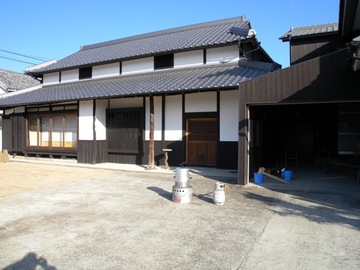
Our hosts from the local area first showed us the ‘kadomatsu’ traditional pine, bamboo, plants and arranged twigs in picture 5. The kadomatsu are seen everywhere in Japan at this time of the year and there are slight stylistic variations in some prefectures and I was told? But now can’t remember because I was too busy fidgeting and blowing into my hands to keep warm. In fact when it came around for my turn tot do the video interview for a couple of seconds my lips wouldn’t work it was that damn cold!

Somehow I got through this and was at the same time fascinated by the beauty of the bonsai.
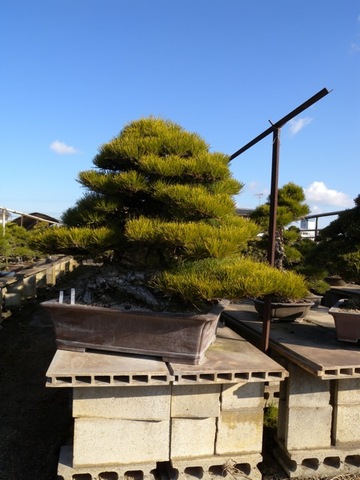
A part of what we were to report on was the upcoming 11th Asia-Pacific Bonsai and Suiseki Convention & Exhibition in Takamatsu running from Nov. 18th (Fri.) through to the 21st (Mon.)
This will be held in a few locations: Takamatsu City, Sunport Takamatsu, Tamamo Park, Ritsurin Garden, Kinashi and Kokubunji area. It will also include Niihama City and Ehime prefecture and Takasago-an Bonsai Garden.
The 11the ASPAC Takamatsu Conference Organizing Committee
31-14 satoh, Kinashi-cho, Takamatsu Kagawa, JAPAN Tel: 087-813-1787 for more information.
info@aspac-takamatsu.jp
http://www.aspac-takamatsu.jp/en/
On show, there will be bonsai from the Imperial Palace, bonsai masterworks, demonstrations, workshops and field tours. The website has more information on this.
Let’s get back to my blog …the last demonstration was making mochi and we all chipped in including a group of kids from the local kindergarten who were invited along. How come kids don’t seem to get cold? I swear they just smiled all the time while I was wriggling around in my clothes.
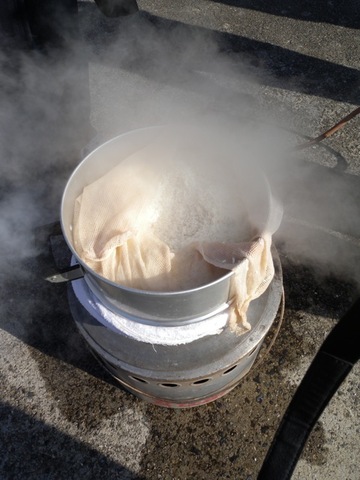
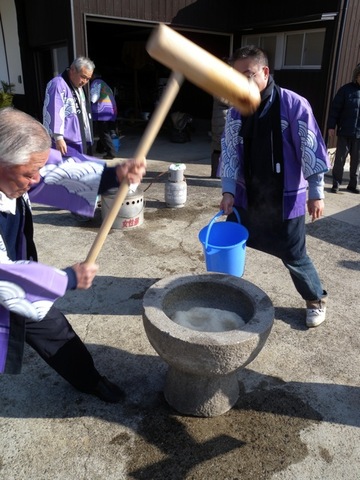
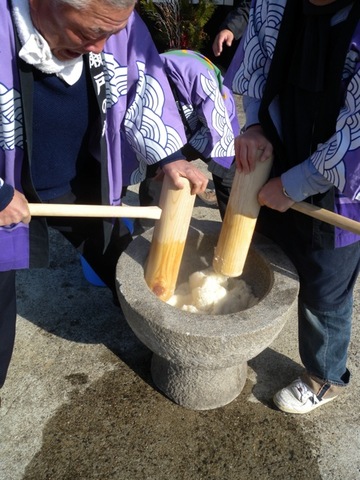
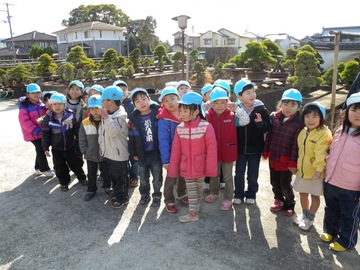
The ‘mochi gome’ (special rice cultivated for making mochi was steamed for about 30 minutes then pounded into a sticky paste. I enjoyed this bit as I could keep warm!
Then we wrapped bits in dried seaweed and dipped it in soy sauce. Apart from locking my jaws together and at least stopping the teeth from chattering it was delicious.
Keep all them cards n’ letters coming in. I’ll be back in February with some good stuff I’m working on now. Have a safe and prosperous year everyone!
My ever modest and wonderful self, a Korean and Chinese colleague were invited out to make a short video in the beautiful Kinashi area. Specifically, to Nakanishi san’s very traditional bonsai farm and report on a few of Japan’s New Years customs, which included making mochi. This is one hell of a beautiful homestead and we were pretty impressed with spaciousness of the place and the traditional architecture.

Our hosts from the local area first showed us the ‘kadomatsu’ traditional pine, bamboo, plants and arranged twigs in picture 5. The kadomatsu are seen everywhere in Japan at this time of the year and there are slight stylistic variations in some prefectures and I was told? But now can’t remember because I was too busy fidgeting and blowing into my hands to keep warm. In fact when it came around for my turn tot do the video interview for a couple of seconds my lips wouldn’t work it was that damn cold!

Somehow I got through this and was at the same time fascinated by the beauty of the bonsai.

A part of what we were to report on was the upcoming 11th Asia-Pacific Bonsai and Suiseki Convention & Exhibition in Takamatsu running from Nov. 18th (Fri.) through to the 21st (Mon.)
This will be held in a few locations: Takamatsu City, Sunport Takamatsu, Tamamo Park, Ritsurin Garden, Kinashi and Kokubunji area. It will also include Niihama City and Ehime prefecture and Takasago-an Bonsai Garden.
The 11the ASPAC Takamatsu Conference Organizing Committee
31-14 satoh, Kinashi-cho, Takamatsu Kagawa, JAPAN Tel: 087-813-1787 for more information.
info@aspac-takamatsu.jp
http://www.aspac-takamatsu.jp/en/
On show, there will be bonsai from the Imperial Palace, bonsai masterworks, demonstrations, workshops and field tours. The website has more information on this.
Let’s get back to my blog …the last demonstration was making mochi and we all chipped in including a group of kids from the local kindergarten who were invited along. How come kids don’t seem to get cold? I swear they just smiled all the time while I was wriggling around in my clothes.




The ‘mochi gome’ (special rice cultivated for making mochi was steamed for about 30 minutes then pounded into a sticky paste. I enjoyed this bit as I could keep warm!
Then we wrapped bits in dried seaweed and dipped it in soy sauce. Apart from locking my jaws together and at least stopping the teeth from chattering it was delicious.
Keep all them cards n’ letters coming in. I’ll be back in February with some good stuff I’m working on now. Have a safe and prosperous year everyone!
Posted by pat at
10:00
│Tasty Foods
OLD and NEW
2012年02月09日
 Just a month or so ago I visited Bushozan with my fellow blogger Cathy Hirano to report on the Daimyo’s parade. We both learned a lot and while I was there I couldn’t help but notice some of the interesting architecture and renovations to old buildings.
Just a month or so ago I visited Bushozan with my fellow blogger Cathy Hirano to report on the Daimyo’s parade. We both learned a lot and while I was there I couldn’t help but notice some of the interesting architecture and renovations to old buildings.

Now I’m not really a big fan of Japanese architecture and that’s because although it’s very beautiful, it’s just not very practical at all. In Japan we warm ourselves with a kotasu table with quilt in the freezing air around the house in winter at least. Shuffling around blowing our noses, rubbing our hands and feel miserable. There has to be a better way other than consuming oil to heat us and there is and it’s called sensible insulation.


This is so poorly utilized in Japan as the houses are designed for air to move around which works just fine in the between seasons; spring and fall. But make no mistake, in summer and winter these houses swelter and freeze. The single-pane windows rattle with the wind and the mud plastered walls on bamboo frames whilst beautiful, are no match for modern insulation techniques. I’m convinced there is some sort of collusion between the Japanese electronics industry, architects and house builders to keep wasteful air-conditioners and heaters sales up…


So what’s a solution? The best of both worlds I think and I saw quite a few examples in Bushozan on my second visit.




There are some wonderful examples of old houses here and some look just great as they are, albeit hard to live in. Others are prime candidates for renovations. What really impressed me was the use of traditional building materials such as roof tiles for other purposes, such as paving. Out of context but so innovative and beautiful. Lots of wabi-sabi here …



The combination of concrete, glass, stainless steel and traditional Japanese design can be pretty spectacular and there are a number of examples in Bushozan to be seen.




As I’d promised, I will get back to take a closer look at the stone carving area of AJi in a few week. Until then, don’t go away and keep all those cards n’ letters coming in. Stay warm.
Posted by pat at
22:39




